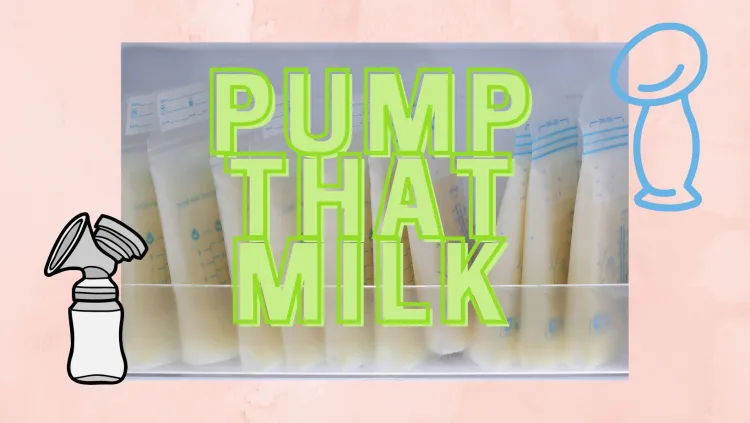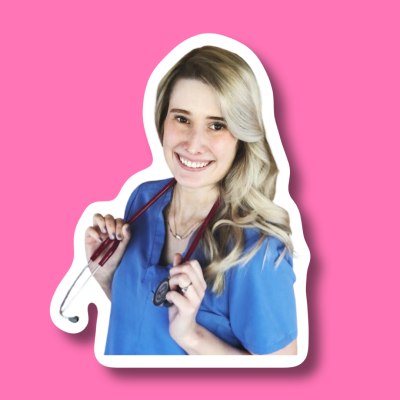Reading Time: mins
As a mother-baby nurse, one of the biggest parts of my job is educating new parents on pumping! It may be really hard to know where to start, so let’s talk about how to get started. If you would like to watch this information in a video, here is one below.
First off, evaluate your reason behind why you want to pump. If your goal is to primarily feed the infant at the breast, then in the first few days after you deliver it’s important to prioritize getting them to latch on your nipple. Babies are born with the natural instinct to nurse, but it still takes practice and training of both you AND baby to learn how to do it! So always attempt to feed the infant at the breast first if that is to be your primary mode of feeding in the future. There are of course people who just want to exclusively pump or may need to due to latch issues, and in that case, we can hop straight into pumping.
If you decide you want to pump in addition to latching baby, I encourage you to feed baby first and then pump after. 5 to 10 minutes on both sides total is fine! The number one way to get your milk supply to “come in” or increase milk supply is stimulation! Either by breastfeeding or pumping. Supplements and other things can help but stimulation is going to be the number one way to get your brain sending those hormone signals to increase milk production.

It’s important to note when we start pumping the first few days after delivery, a good, high quality pump is important. If you’re in a hospital with pumps you can use, take advantage! Those pumps are worth thousands of dollars and do the best job of stimulating. Although I love Haakaas and they’re amazing, those just apply suction, and we need stimulation if we’re trying to get milk to come in or if we want to properly drain the breast. Most insurances will cover a breast pump for free–just call and ask yours! But a double electric breast pump is going to be one of the best things to have if you want to pump.

Every pump is going to be a little bit different in the set-up, so have your nurse or lactation consultant show you how to plug everything in. Typically, every brand has a set of flanges (the fanned out part that goes over your nipples), the bottle that collects the milk, small pieces or membranes between the flange and bottle, the tubing, and then the pump itself. After every pump session, all the pieces where milk touches needs to be washed. That includes every piece I mentioned above except the tubing and pump itself. Make sure when you wash you disassemble all parts (as mold can grow in little crevices if you don’t). Just wash in some warm, soapy water with a mild dish soap. You can then leave out to air dry on a towel or rack until the next pump session.
You are supposed to sanitize the pump parts and bottle every 24 hours. One way you can do this is to boil all parts in boiling water for 10 minutes on a stove. I personally love the disposable steam sterilizer bags or you can also buy reusable ones. They work by steaming in a microwavable bag for just 3-5 minutes.

I get asked a lot on my TikTok page (@karathebabynurse) if you can pump before baby arrives, and the answer is, “yes!” Just make sure you double check with your provider first before doing this as the oxytocin released when pumping can sometimes start labor. If you are high risk or have certain health issues it might be contraindicated to start pumping while pregnant, which is why you should always get clearance first. If your doctor gives you the green light, then many people usually start pumping just a little bit anywhere between 36-40 weeks.
If you want to use a Haakaa pump or hand expression as well rather than an electric pump that’s also a great method. If you’re a first time parent, you might only get drops (or even nothing at all the first few sessions!). Don’t worry, this doesn’t mean you won’t make milk when baby comes. A lot of times it takes 3-5 days for milk to fully “come in” after delivery. If you do get some drops when you express or pump, you can save them in small syringes (a lot of medical offices or the hospital will be able to give you some for free if you ask or you can buy some on Amazon here). If you start pumping large quantities then you can store them in bigger breastmilk storage bags.
Many people want to build up a “stash” of milk (you may want to do this so there’s milk available for others to give baby if/when you return to work or if you are away from baby). I know we see a lot of influencers or parents online with these HUGE deep freezers full of milk–however that is not the norm. Most people are not overproducers to that extent, so do not be discouraged if you feel like you aren’t making as much milk as these other people. Your milk the first 6-8 weeks of baby’s life usually is overabundant. Your supply is typically more than baby needs because it hasn’t figured out exactly how much to make for your baby and it hasn’t regulated the “supply and demand” system yet. So typically, during those first weeks if you are making extra milk anyway, I like the technique of applying the Haakaa on the opposite side on which you’re feeding to collect that extra milk released during your let-down. If you also want to feed baby then pump for a few minutes after this is also a great way to build up that extra stash.

"*" indicates required fields